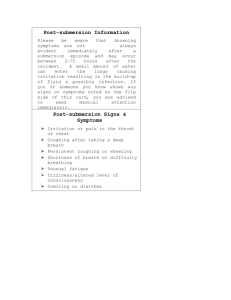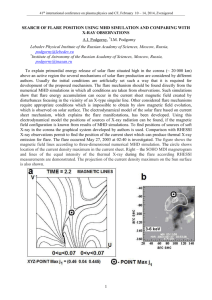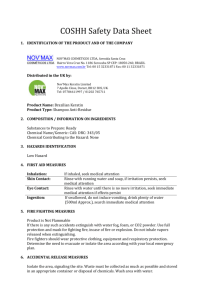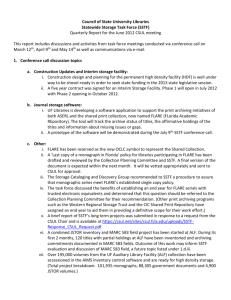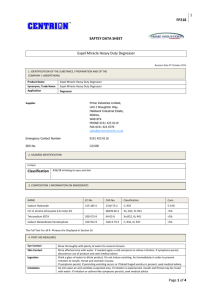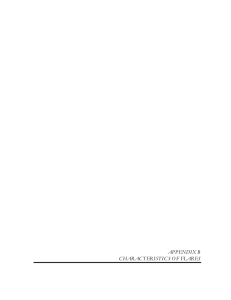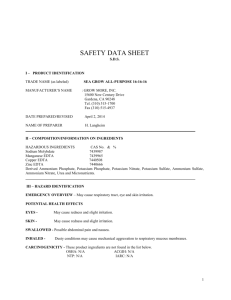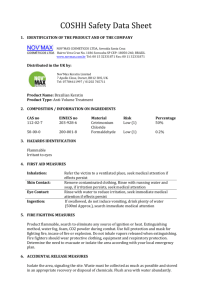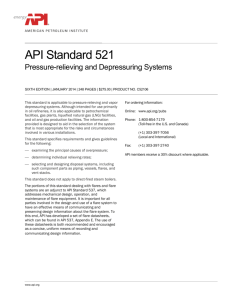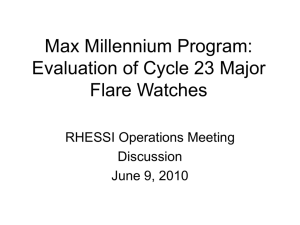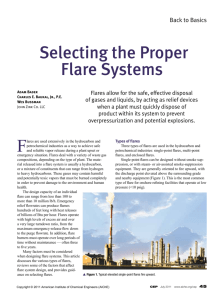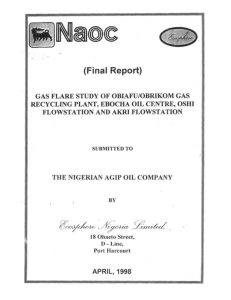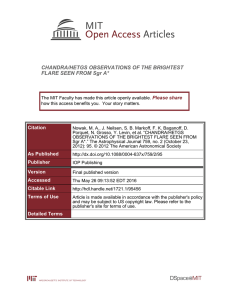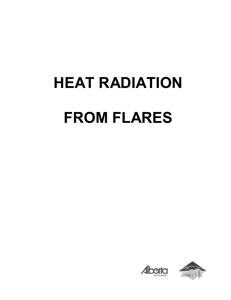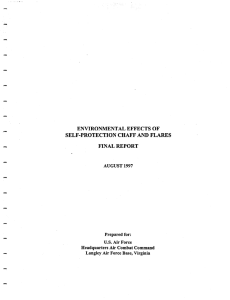ICE MSDS
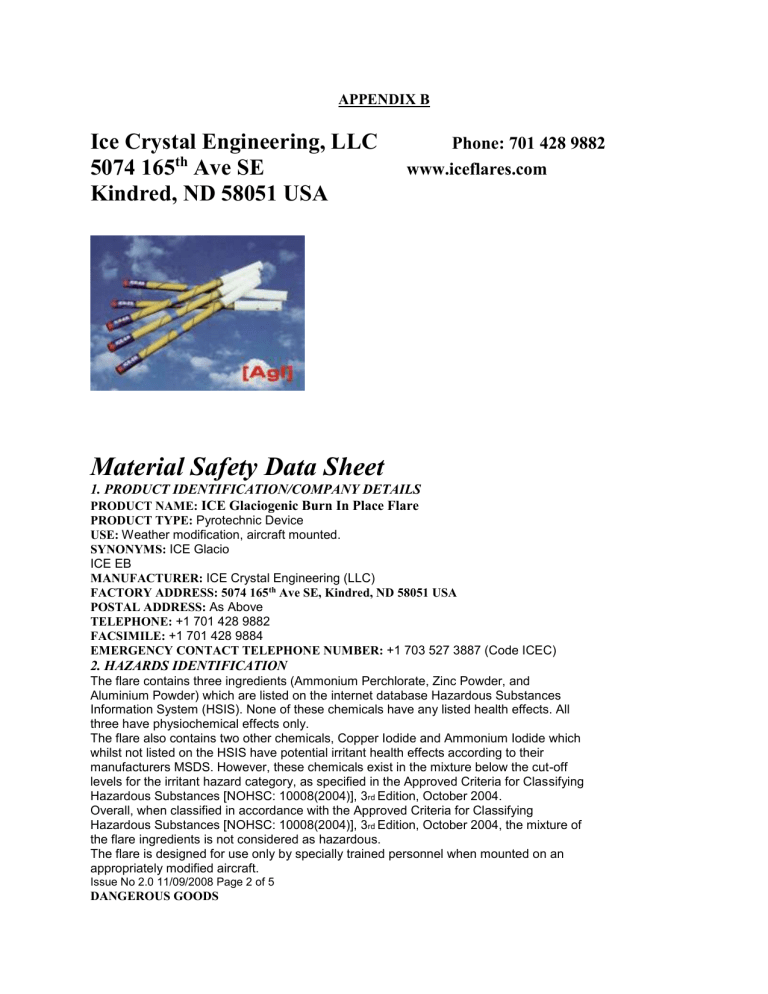
APPENDIX B
Ice Crystal Engineering, LLC Phone: 701 428 9882
5074 165
th
Ave SE www.iceflares.com
Kindred, ND 58051 USA
Material Safety Data Sheet
1. PRODUCT IDENTIFICATION/COMPANY DETAILS
PRODUCT NAME:
ICE Glaciogenic Burn In Place Flare
PRODUCT TYPE: Pyrotechnic Device
USE: Weather modification, aircraft mounted.
SYNONYMS: ICE Glacio
ICE EB
MANUFACTURER: ICE Crystal Engineering (LLC)
FACTORY ADDRESS: 5074 165 th Ave SE, Kindred, ND 58051 USA
POSTAL ADDRESS: As Above
TELEPHONE: +1 701 428 9882
FACSIMILE: +1 701 428 9884
EMERGENCY CONTACT TELEPHONE NUMBER: +1 703 527 3887 (Code ICEC)
2. HAZARDS IDENTIFICATION
The flare contains three ingredients (Ammonium Perchlorate, Zinc Powder, and
Aluminium Powder) which are listed on the internet database Hazardous Substances
Information System (HSIS). None of these chemicals have any listed health effects. All three have physiochemical effects only.
The flare also contains two other chemicals, Copper Iodide and Ammonium Iodide which whilst not listed on the HSIS have potential irritant health effects according to their manufacturers MSDS. However, these chemicals exist in the mixture below the cut-off levels for the irritant hazard category, as specified in the Approved Criteria for Classifying
Hazardous Substances [NOHSC: 10008(2004)], 3 rd
Edition, October 2004.
Overall, when classified in accordance with the Approved Criteria for Classifying
Hazardous Substances [NOHSC: 10008(2004)], 3 rd
Edition, October 2004, the mixture of the flare ingredients is not considered as hazardous.
The flare is designed for use only by specially trained personnel when mounted on an appropriately modified aircraft.
Issue No 2.0 11/09/2008 Page 2 of 5
DANGEROUS GOODS
The product is classified as Dangerous Goods, 1.4S
, in accordance with the
Australian Code for the Transport of Explosives by Road and Rail, 2 nd ed., March 2000.
CLASS: 1.4S U.N. NO: 0432
SUBSIDIARY RISK: Nil
Risk Phrases
The following risk phrases relate to the finished product when stored, transported, and handled appropriately.
R10 Flammable.
R36/37 Irritating to eyes and respiratory system
The following risk phrases relate to the mixture contained within the flare and are applicable only if the casing is breached.
R9
Explosive when mixed with combustible material.
R10 Flammable.
R15 Contact with water liberates extremely flammable gases.
R36/37/38 Irritating to eyes, respiratory system and skin
R44 Risk of explosion if heated under confinement.
Safety Phrases
The following safety phrases relate to the finished product when stored, transported, and handled appropriately.
S1/2 Keep locked up and out of the reach of children.
S16 Keep away from ignition sources – No smoking.
S35 This material and its container must be disposed of in a safe way.
S41 In case of fire do not breathe fumes.
The following safety phrases relate to the mixture contained within the flare and are applicable only if the casing is breached.
S1/2 Keep locked up and out of the reach of children.
7/8 Keep container tightly closed and dry
S22 Do not breathe dust.
S24 Avoid contact with skin.
S27 Take off immediately all contaminated clothing.
S36/37 Wear suitable protective gloves/clothing.
S43 In case of fire use water.
3. COMPOSITION / INFORMATION ON INGREDIENTS
The pyrotechnic composition consists of (~70%) Ammonium Perchlorate, Zinc powder
(non pyrophoric), Aluminium powder (non pyrophoric), and an organic binder. The remainder (~30%) consists of Silver Iodide, Copper Iodide, and Ammonium Iodide.
4. FIRST AID MEASURES
In the unlikely event of receiving burns from this device, seek medical attention immediately.
Exposure to the smoke may cause irritation to the eyes. Move the patient to fresh air.
Symptoms that may arise if the product is mishandled are:
Ingestion: Symptoms. Discomfort
Give plenty of water to drink but only if conscious. Do not induce vomiting. Seek medical attention at once.
Issue No 2.0 11/09/2008 Page 3 of 5
Eye Contact: Symptoms. Irritation
Immediately flush the eyes with copious quantities of water. Eyelids to be held open. If irritation persists seek medical advice.
Skin Contact: Symptoms. Irritation
Wash the exposed area with copious amounts of soap and water. Remove contaminated clothing and wash before reuse. If irritation occurs seek medical advice
Inhalation: Symptoms. Throat irritation, shortness of breath
Remove to fresh air. If not breathing, give artificial respiration. If breathing is difficult, give oxygen. If irritation persists, seek medical assistance.
5. FIRE FIGHTING MEASURES
In the case of fire, isolate the immediate area and deny entry.
In the event of a fire or intense heat that reaches the storage/cargo area, the pyrotechnic articles are likely to ignite. They will burn, spreading burning particles over a limited area.
A mass explosion is not expected. Smoke and potentially irritating gases will be produced in a fire.
Fire can be fought with water spray if necessary, although disposal and clean up will be simplified if material is allowed to burn. If flares are exposed to heat and flames, flood with water, or direct water spray on outside of container to cool it down. Continue spray until well after fire is out. Self contained breathing apparatus (SCBA) and structural firefighter’s protective clothing will provide some limited protection.
Vehicle fire (other than cargo area): Flood with water. Tyre fires may start again.
Unhook and separate vehicle from trailer (if applicable and possible). Remove vehicles that are not involved in fire from fire area if you can do so without risk. If cargo area is exposed to heat and flames, direct water spray on outside of container to cool it down.
Cargo Fire: Do not move cargo or vehicle if cargo has been exposed to heat. Withdraw from area if and when fire reaches cargo and let fire burn if situation allows. If fire must be fought, flood with water spray. Use firefighting team to prevent spread of fire to adjacent structures and materials.
For additional information, call the shippers emergency telephone number at +1 703 527
3887 (Code ICEC)
6. ACCIDENTAL RELEASE MEASURES
Remove all ignition sources.
If the pyrotechnic articles are spilled as the result of an accident but do not ignite, they can safely be picked up and repackaged. The area should be kept clear of unnecessary people while this is being done. There shall be no flares, smoking and/or tools capable of producing sparks or flames in the vicinity of the spilled material. Cautiously pick up the spilled devices, place them in cardboard cartons and dispose in accordance with local regulations. The site should be cleaned up with water.
7. HANDLING AND STORAGE
The composition is an explosive (Class 1) and hence should be handled and stored in accordance with the Explosives Regulations of the relevant Competent Authority.
Store in manufacturer’s approved packaging in a dry area away from sources of heat and direct sunlight. The shelf life of this product is indefinite if stored properly.
Issue No
8. EXPOSURE CONTROLS AND PERSONNEL PROTECTION
No chemical composition is released or exposed during normal handling, storage and transportation.
9. PHYSICAL AND CHEMICAL PROPERTIES
The flare consists of 150 grams of glaciogenic pyrotechnic composition glued into a phenolic paper tube with the igniter held into the end and sealed with a plastic cap. The electronic igniter is fired using the voltage supplied from the aircraft to the firing box.
When activated the flare burns for between 3.5 and 4 minutes. The temperature of ignition is in excess of 260º Celsius.
10. STABILITY AND REACTIVITY
Stability
This device is stable under normal conditions.
Solubility
The device is sealed from water ingress.
Reactivity
Not applicable.
Chemical Incompatibilities
None known.
11. TOXICOLOGICAL INFORMATION
No adverse health effects are expected if the product is handled according to this MSDS.
If mishandling occurs, consult first aid measures above.
The most likely route of exposure would be by inhalation of the gases following combustion. It is recommended that any effects from inhalation of the gases should be treated as outlined in Section 4: First Aid Measures.
12. ECOTOXICITY INFORMATION
Spillage of the composition or deposition of the reaction products in the soil or aquatic environment may represent a short term hazard.
If contamination of the waterways occurred this would be expected to be of a fairly low level. In the event of spillage of the flares, they should be cleaned up in accordance with
Section 6 Accidental Release Measures.
13. DISPOSAL CONSIDERATIONS
Damaged or inappropriately stored flares should be destroyed under controlled conditions in accordance with local regulations.
14. TRANSPORT INFORMATION
CLASS: 1.4S U.N. NO: 0432
Proper Shipping Name: Articles, pyrotechnic
Gross Weight: 270 grams NEQ: 150 grams
Packaging instruction 135 for Inner and Outer Packaging (Australian Code for the transport of Explosives by Road and Rail, 2 nd ed, March 2000, Appendix A4).
Issue No 2.0 11/09/2008 Page 5 of 5
